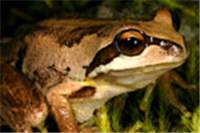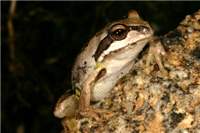Family
Hylidae
Genus
Litoria
Species
verreauxii verreauxiiThreats/Control Methods - Regional
Broadscale threatening processes include; salinisation, habitat modification and urbanisation.
Like many other frog species, is thought to be vulnerable to the effects of Chytrid fungus. When entering frog habitats care should be taken at all times due to the risk of spreading disease, including the Chytrid fungus (chytridiomycosis). To prevent the spread of the Chytrid fungus it is important to wash your shoes before entering and after leaving frog habitats.
For more information on the Chytrid fungus © Link to fact sheet http://www.deh.gov.au/biodiversity/invasive/publications/c-disease/
Local/Urban Actions
You can encourage frogs including L. v. verreauxii into your own backyard by including habitat features in your garden. The Ginninderra Catchment Group, Australian National University and Environment ACT have developed a guideline to help you encourage frogs into your backyard called Creating a Frog Friendly Habitat in the ACT Community.
You can also get involved in monitoring local frog populations. Frogwatch is an annual program run to monitor the presence and abundance of frogs within the ACT region. The Frogwatch program provides training for community volunteers each October, with monitoring then being undertaken by volunteers over a two week period.
For more information on Frogwatch contact:The ACT Frogwatch Coordinator, Ginninderra Catchment Group; Ph (02) 6278 3309 or email: [email protected]
Distinguishing Features
Adult frogs range in size from 2.5-4cm, with colouring ranging from fawn brown to reddish brown. Dark brown to black patches mark the back, extend from the nostril to the forearm, and from the top of the head (behind the eye) down either side of the spine, and between the front and back legs. The groin and thighs are a yellow/orange colour. Tadpoles are pale yellow to grey and may reach 5cm in length.
Common name/s
Whistling Tree Frog, Verreaux's Frog
Similar Species
L. verreauxii verreauxii is very similar to L. verreauxii alpina in appearance, however, the two sub-species can be distinguished from one another through their calls; the call of L. verreauxii verreauxii is described as a whistling ©cree© cree©cree©, while the call of L. verreauxii alpina is slower and with less of a whistle. The habitat of the two species also differs, the alpina population being present at higher altitudes (hense the name 'alpina') between Marysville and Canberra, and the verreauxii population habiting in the lowlands. The back of the alpine species is also characterised by raised warts, that are absent on the lowland species.
Distribution
This species is found in much of the ACT region, extending from the south-east corner of QLD, along the eastern edge of NSW, and eastern Victoria.
Country of Origin
Australia
Survey Techniques
The most common technique for monitoring frog populations is based on call identification, with each frog species having a unique call. Frogs should not be handled without the use of sterile gloves, as their skin is very sensitive to chemicals, including sunscreen and soap.
Conservation (Pet/Pest) Status - National
Currently not thought to be at risk
Conservation (Pet/Pest) Status - Regional
Currently not thought to be at risk
LSCCES Population
The species suffered a decline in the 1980's, but has since recovered. It is not thought to currently be at risk. In the 2004 Frog watch census this species was located in 24% of the observed sites.
Associated Vegetation Community
Commonly found in water bodies within sclerophyll forests, bogs, grasslands, swamps, lagoons and farm dams.
Breeding
Males can be heard calling all year round, most commonly after rain, although the breeding season is usually from late winter though summer. Eggs are laid in jelly clumps and may be found attached to floated vegetation in water.
Behaviour
Although heard all year round the species is not often seen outside of its breeding season. Despite being called a tree frog, the species is a land dwelling species (terrestrial) with poor climbing prowess.
Functional Group
Insectivorous
Food Species
Small insects including beetles.
Predators
May include native birds, such as the White-Faced Heron (Egretta novaehollandiae) and Intermediate Egret, and fish, including the introduced Carp, Goldfish and Trout. Introduced species such as Cats (Felis catus) and Foxes may also predate on frogs.
References - (reader suitability of references, P=Primary teachers, S=Secondary students, T=Tertiary students and researchers)
Books:
Barker, J., Grigg,G., Tyler, M. (1995). A Field Guide to Australian Frogs. Surry Beatty & Sons. NSW, Australia. S, TLintermans,M. & Osborne, W. (2002). Wet & Wild: A Field Guide to the Freshwater Animals of the Southern Tablelands and High Country of the ACT and NSW. Environment ACT. Canberra, Australia. S, TRobinson, M. (1993). A Field Guide to Frogs of Australia. Australian Museum/Reed books. NSW, Australia. S, TTurner, J. (2004). Frogs of Australia. Pensoft. Bulgaria. P, STyler, J. (1994). Australian Frogs: A Natural History. Reed New Holland. Australia. S, TSwan, G.(2001). Green Guide: Frogs of Australia. New Holland Publishers. Sydney, Australia. P, S
Online Publications:
Amphibian Research Centre. (2005). Available Online: http://frogs.org.au/frogs/species/Litoria/verreauxii/ S, TAustralian Frogs Database (2005.). Litoria verreauxii verreauxii. Available Online: http://frogsaustralia.net.au/frogs/display.cfm?frog_id=190 S, TDepartment of Environment and Heritage, (2004). Chytridiomycosis Factsheet http://www.deh.gov.au/biodiversity/invasive/publications/c-disease/ S, TEnvironment ACT. (2004). Summary of results. Available online: http://www.environment.act.gov.au/Files/frogwatchoctober2004summary.pdf P, S, TEnvironment ACT. (2004). Litoria vereauxii; Whistling Tree Frog. Available online: http://www.environment.act.gov.au/Files/frogwatchoctober2004-litoriaverreauxiiresults.pdf S, TZoological Parks and Gardens Board. Frog Pond Checklist. Available Online: http://www.zoo.org.au/education/factsheets/amp-frog_pond_checklist.pdf P, S, TSpeare, R et al (1998). HOW TO REDUCE THE RISKS OF YOU TRANSMITTING AN INFECTIOUS AGENT BETWEEN FROGS AND BETWEEN SITES. Available Online: http://www.jcu.edu.au/school/phtm/PHTM/frogs/prevent.htm S, TZoological Parks Board N>S>W. (2005.). ASX Frog Focus. Available online: http://www.asxfrogfocus.com/ P, S (School activity program)
Researcher: Pippa Jaminon



 Top
Top Top
Top